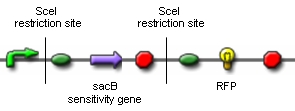|
Overview
In order to approach our goal of creating an E. coli strain carrying a minimal genome, there are three main problems that have to be overcome:
Genome reduction: show that in vivo restriction and religation is possible
Chemostat selection: introduce a limitation that confers a growth advantage to organisms with smaller genomes
Switch circuit: design a biobrick that provides for short-term synthesis of the desired gene products
To prove that in vivo restriction and religation is possible is fundamental to our project which relies on short-term expression of a restriction enzyme and a ligase. While the restriction enzyme will randomly cut DNA, the simultaneous or shortly delayed synthesis of the ligase should religate the DNA. If the DNA is cut at several sites, religation will lead to exclusion of chromosomal fragments in a random manner.
In the continuous culture of a chemostat, those organisms with the highest rate of proliferation will overgrow those with a smaller growth rate. In order to bypass the need of selecting for those E. coli which have successfully reduced their genomes by massive screening of thousands of clones, we need to introduce a constraint that confers a growth advantage to organisms with smaller genomes. We have chosen to introduce mutations in the nucleotide synthesis pathway to achieve this goal. This will render DNA replication the rate-limiting step of proliferation and therefore be advantageous to organisms with small genomes.
Expression of restriction enzymes that cut genomic DNA inside the cell is likely to decrease viability. Actually, the Waterloo iGEM team is using restriction enzymes to kill the cell in their project this year. Therefore, construction of a switch circuit, which allows to restrict expression of the restriction enzyme to a short period of time, is a crucial part of the project.
Summary
Lab overview
|
1) Genome Reduction
Questions:
- Is in vivo restriction and religation possible without killing the cell?
- Does in vivo restriction and religation lead to the exclusion of chromosomal fragments?
Method:
For our proof of concept we ordered the above construct. Only if in vivo restriction by the endonuclease SceI and religation by the T4 ligase leads to the exclusion of the sacB sensitivity gene and the terminator, RFP will be synthesized. RFP-synthesizing cells can then be detected. Unfortunately, the construct has not arrived until today. Therefore, we are working on an alternative construct, which contains an RFP flanked by two SceI restriction sites. In this case, successful in vivo restriction and religation will lead to the loss of the RFP, which can also easily be detected.
Results:
We cloned a lac-inducible promoter in front of SceI and various inducible and constitutive promoters in front of the T4 ligase. During our attempts to design the construct coding for RFP flanked by SceI restriction sites, we managed to insert both restriction sites in front of and after the RFP by annealing oligonucleotide duplexes.
|
2) Chemostat selection
Questions:
- Is it possible to slow growth of large genome strains by using a thymidine auxotrophyc strain and limiting thymidine feeding?
- What is the best restriction enzyme to be used in order to maximize genome reduction and at the same time vitality (growth rate) of thymidine auxotrophyc strains?
- What is the predicted genome reduction difference if the medium is minimal or very rich in terms of nutrients?
- Which are the predicted quantitative differences in terms of growth rate and genome size of strains on which has been applied the selection procedure?
Method:
The state-of-the-art genome scale model for E.Coli iAF1260 (1,260 genes included) was modified in order to account for thymidine auxotrophycity, thymidine uptaking limitation, genome reduction and growth on different medium. Stochastic algorithm and flux balance analysis were applied to predict growth rates.
Results:
Models show that is indeed possible to select reduced genome strains using thymidine limitation. The quantification shows that the method is at the border line with the sensitivity of chemostat machinery setup for small differencies, but is effective for big reductions (from approximately 10 Kbp on). Predictions show the possibility of reducing up to 61 % of genes for a minimal medium growing strains (corresponding to 59% of chromosome size) and 73 % of genes for rich medium growing strains (corresponding to 71% of chromosome size).
|
|
3) Switch circuit
Questions:
- What are the ideal settings of nutrient concentrations and influx in order to select reduced strains?
- Which is the sensitivity regarding growth rate selection?
- What are the timing parameters that frame the induction of two subsequent rounds of restriction enzyme expression?
Method:
A classical chemostat model using Ordinary Differential Equations was constructed and analyzed in terms of sensitivity analysis and simulation of realistic data.
Results:
|
|
On the following pages, we will show a detailed description of how we are trying to achieve these three goals.
|
 "
"
